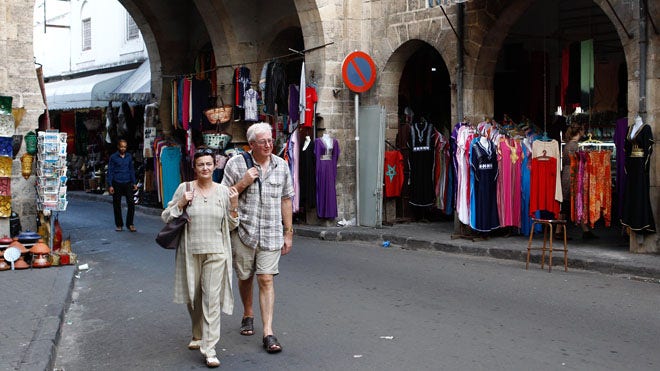Associated Press

Tourists stroll through Casablanca, Morocco’s Habous district, built by the French in the 1920s to resemble a traditional Moroccan medina. (AP)
CASABLANCA, Morocco – Despite its romantic Hollywood associations, the sprawling ocean-side city of Casablanca is often overlooked by tourists heading for the beach or Morocco’s more exotic cities like Marrakech. But this bustling city of 4 million, Morocco’s commercial capital, is a vibrant mix of old and new with gorgeous art-deco architecture, traditional souqs (markets), one of the world’s largest mosques and some picturesque beaches of its own.
The kingdom of Morocco also has the reputation of being the most stable country in North Africa and has been largely spared the unrest and protests that have erupted elsewhere across the region.
THE DOWNTOWN
A small port city until the French chose it as the capital of its “protectorate” over Morocco in 1912, Casablanca blossomed under the attention of some of France’s foremost architects who now had room to create outside the crowded cities of Europe. The nouvelle ville, as the downtown was known, was done in an art deco meets Middle Eastern style that is still stunning to behold, if you can look up long enough while dodging crowded sidewalks and zooming cars.
Luckily, the center of it all, the elegant Mohammed V Boulevard, has been made a pedestrian street while a new tram system is installed. So until the sleek French-built trams start running by the end of the year, you can stroll down the middle of the street, admiring the handsome buildings from the 1920s and 1930s.
THE “NEW” OLD CITY
Like most Moroccan cities, Casablanca has a “medina” or walled old city of winding alleys, except here it’s smaller than most and quite run down, with most shops devoted to day-to-day items that are of little interest to the visitor. The French decided in the 1920s they would build a nicer medina and created the Habous neighborhood just a 15-minute drive away featuring elegant arches and whitewashed buildings.
Habous is much cleaner and quieter than the downtown and is filled with handicrafts shops selling the traditional ceramics, leather slippers, embroidered caftans and metal lamps that tourists flood to Morocco to buy. Since most of the customers are locals as well, the quality tends to be higher than the tourist bazaars of Marrakech. There is also little of the hard sell that can blight a trip to the market in some of the other cities.
THE MOSQUE
In the medieval world, kings left their mark by building massive monuments in their name. A modern king, Hassan II of Morocco, who ruled the country for almost four decades until 1999, did the same. Amid the crashing waves of the Atlantic, he built a mosque so enormous it looms over the whole city, with a retractable roof and a laser on the minaret. Faced with pale stone and ornamented with colorful inlaid geometric patterns and traditional tiles, it can hold 25,000 worshippers inside. The vast esplanade around the mosque is often filled with families enjoying the open space and the quiet, and there’s a great view of the sea. The mosque was built through mandatory contributions from all citizens. Unlike most mosques in Morocco, non-Muslims are allowed inside, but only on guided tours in the mornings and afternoons that run $15 a person.
THE BEACH
Once on the city’s coast, keep heading south toward the Ain Diab area, where the nicest beaches can be found. First there are the hotels and nightclubs of the wealthy Anfa district, but eventually they peter out and what’s left is the corniche, a kind of boardwalk, with some great beaches pounded by Atlantic waves. Along the road there are popcorn and drink vendors, while on the beach itself young men offer pony or horse rides to adults and children alike. Dress tends to be a bit more modest than Western beaches, but is more liberal than many other Islamic countries and women can be seen in the water wearing bathing suits.
At the end of the beach, as the sand turns to rocks, there also sits the saint’s tomb of Sidi Abdel Rahman, nearly entirely surrounded by water. The shrine to the holy man is also home to about a dozen families who have clustered their huts around the tomb. The beach area nearby is filled with picnicking families under umbrellas and little stalls serving mint tea.
THE MALL
Just beyond the saint’s shrine looms the shiny bulbous mass of Morocco’s first luxury mall. In the 10-minute walk from the shrine to the glass doors of the Imax cinema, you can move from the extremes of Morocco’s social classes. Inside it’s all Ralph Lauren and Christian Dior with an enormous fish tank featuring small sharks. In the fenced-off outside area, the musical fountain performs every hour. Most Moroccans can’t afford the luxury items on sale, but the place is always packed. People window shop across the three floors and gawk at how Morocco’s 1 percent aspires to live.
Read more: http://www.foxnews.com/travel/2012/10/11/5-free-things-to-casablanca-morocco-bustling-art-deco-commercial-capital-on/#ixzz296UiLHi5
.






